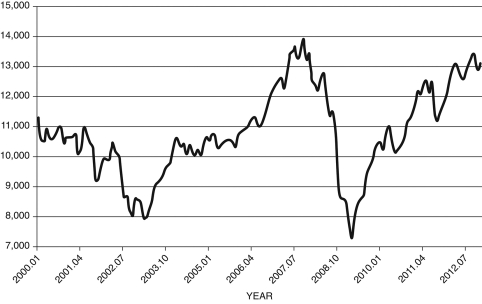Multiple Choice
Refer to the following figure when answering the next two questions.
Figure 17.2: Dow Jones Industrial Average: 2000-2012 
(Source: Federal Reserve Economic Data, St. Louis Federal Reserve)
-Your uncle asks you to explain stock prices based on the financial capital arbitrage equation. He shows you the graph shown in Figure 17.2. He asks you to explain the cause in the rise of stock prices for the years 2002-2006. What do you tell him?
A) "As the DJI rises, there are financial capital gains that drive up stock prices."
B) "The rise in the DJI implies there was an incentive for Congress to increase corporate tax rates, which would have led to falling capital investment. With less capital, stock prices rise."
C) "The rising DJI leads to falling dividend payments, which would lead to a decline in physical capital accumulation. With less capital available, the marginal product of capital rises, leading to higher stock prices."
D) "A rising DJI decreases the MPK."
E) "Rising capital gains, as shown in the figure, have no impact on stock prices."
Correct Answer:

Verified
Correct Answer:
Verified
Q2: If the growth rate of the capital
Q3: Figure 17.4: Capital Arbitrage <img src="https://d2lvgg3v3hfg70.cloudfront.net/TB4306/.jpg" alt="Figure
Q5: The company that was one of the
Q9: In the growth model, we assumed
Q22: The conclusion of a study by Steven
Q32: According to the financial asset arbitrage equation,
Q42: See Figure 17.6 below.<br>Also, as <img src="https://d2lvgg3v3hfg70.cloudfront.net/TB6622/.jpg"
Q44: The arbitrage condition for capital shows that
Q46: For the profit-maximizing firm, if the real
Q112: From the residential arbitrage equation, a rise